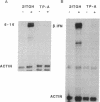Abstract
Constructs expressing the core, surface, X, or polymerase proteins of hepatitis B virus were transfected into human cells. In transient assays, only the polymerase inhibited the responses to interferons alpha and gamma (IFN-alpha and -gamma). Stable expression of the polymerase was achieved in the cell line 2fTGH, which carries an IFN-inducible marker gene, by growth under conditions that select for inhibition of the response to IFN-alpha, but the clones grew poorly. When expressed alone, the terminal protein domain of the polymerase gene inhibited the response to IFN-alpha and the reverse transcriptase plus RNase H domains appeared to be toxic. Clones of cells expressing terminal protein alone, selected for the loss of response to IFN-alpha, grew normally and had no detectable response to IFN-alpha, IFN-gamma, or double-stranded RNA. Binding of IFN-alpha to these cells was not impaired but did not lead to activation of the E alpha subunit of the IFN-induced transcription factor E. These observations are of potential importance in relation to the pathogenesis of chronic hepatitis B virus infection and the resistance of such infection to IFN-alpha therapy.
Full text
PDF
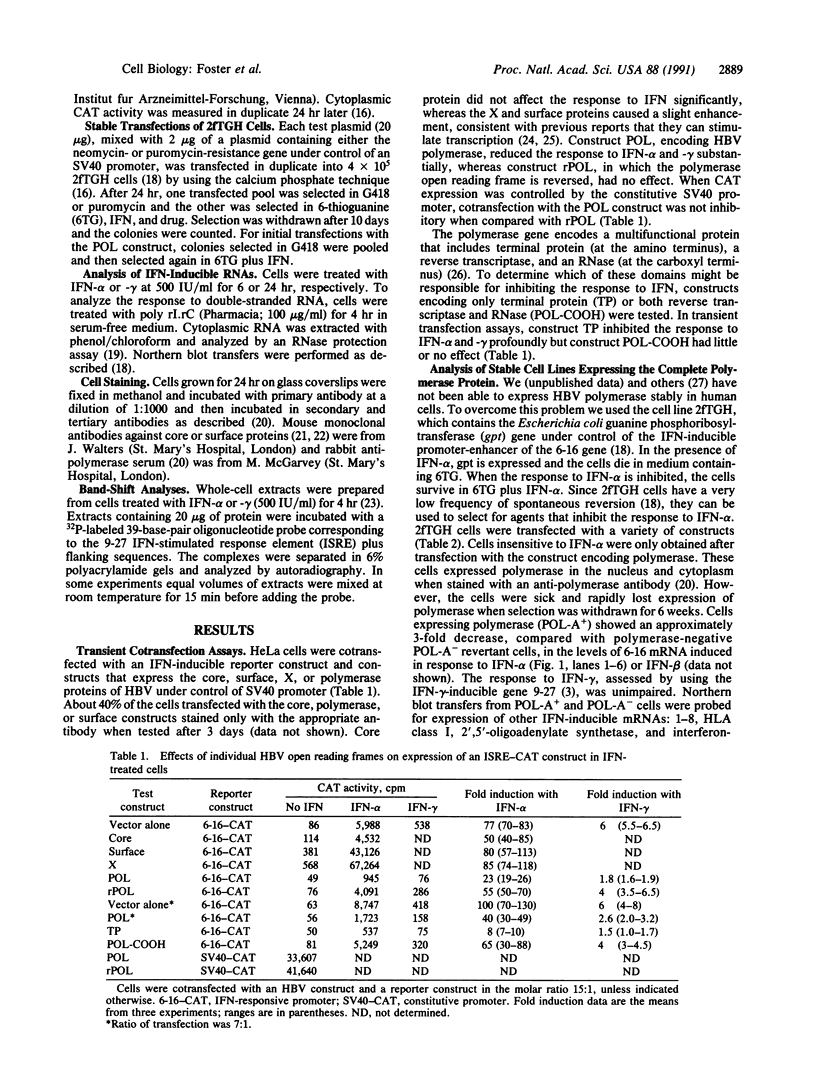
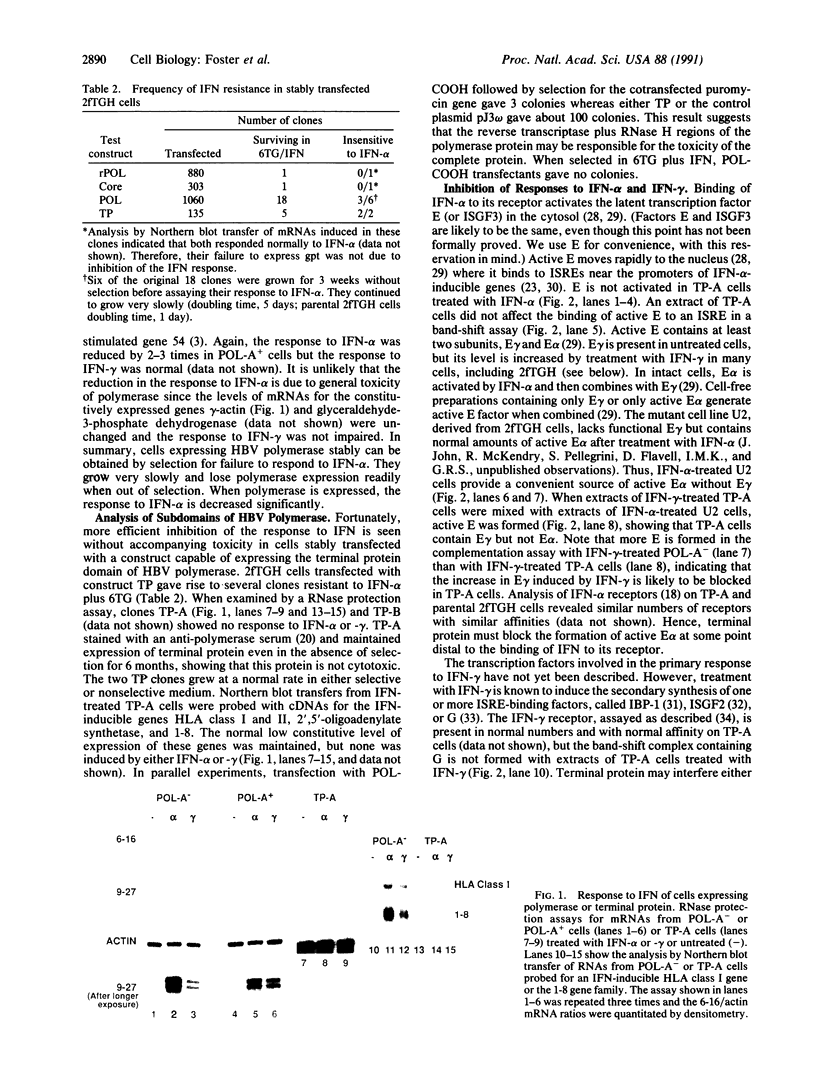
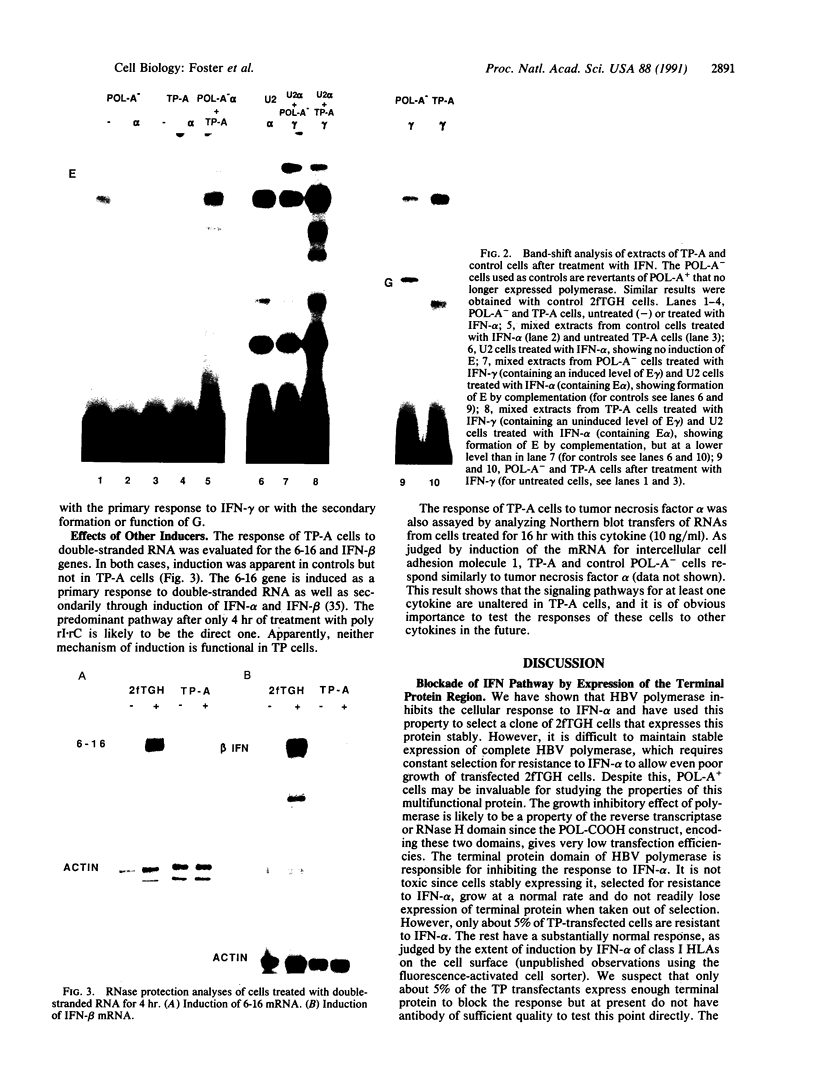
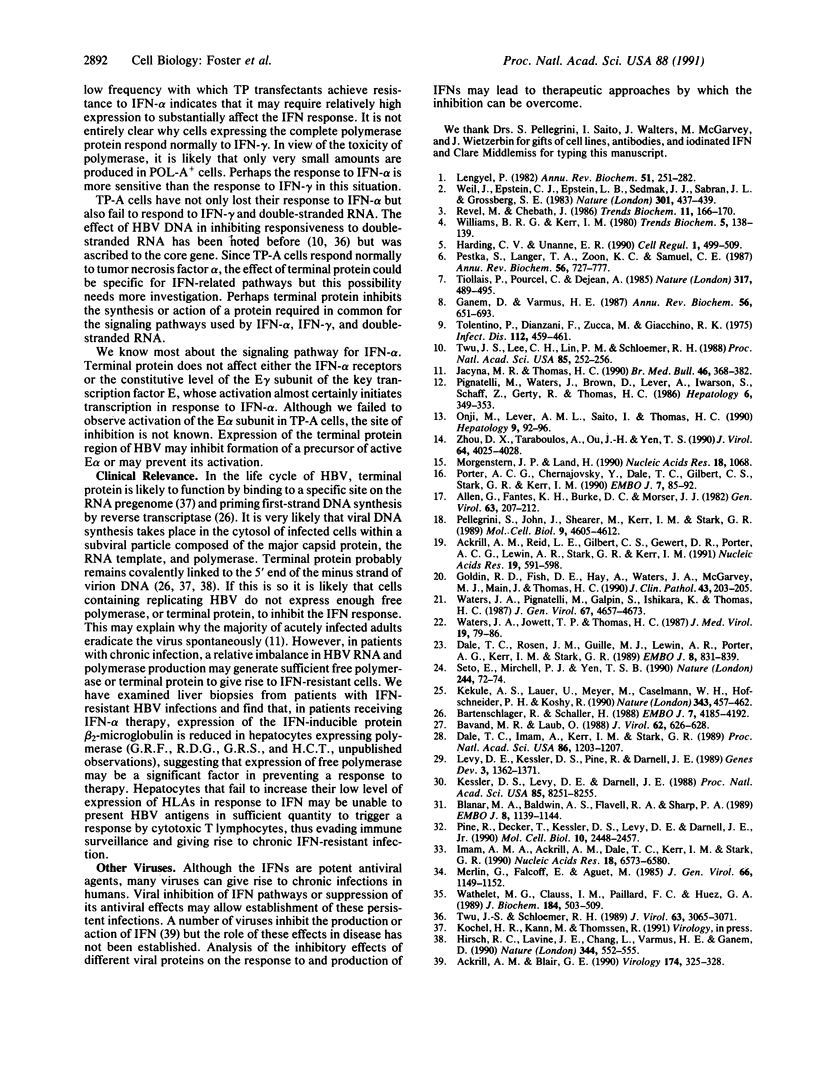
Images in this article
Selected References
These references are in PubMed. This may not be the complete list of references from this article.
- Ackrill A. M., Blair G. E. Interferon-gamma regulation of major histocompatibility class I gene expression in rat cells containing the adenovirus 12 E1A oncogene. Virology. 1990 Jan;174(1):325–328. doi: 10.1016/0042-6822(90)90084-5. [DOI] [PubMed] [Google Scholar]
- Ackrill A. M., Reid L. E., Gilbert C. S., Gewert D. R., Porter A. C., Lewin A. R., Stark G. R., Kerr I. M. Differential response of the human 6-16 and 9-27 genes to alpha and gamma interferons. Nucleic Acids Res. 1991 Feb 11;19(3):591–598. doi: 10.1093/nar/19.3.591. [DOI] [PMC free article] [PubMed] [Google Scholar]
- Allen G., Fantes K. H., Burke D. C., Morser J. Analysis and purification of human lymphoblastoid (Namalwa) interferon using a monoclonal antibody. J Gen Virol. 1982 Nov;63(Pt 1):207–212. doi: 10.1099/0022-1317-63-1-207. [DOI] [PubMed] [Google Scholar]
- Bartenschlager R., Schaller H. The amino-terminal domain of the hepadnaviral P-gene encodes the terminal protein (genome-linked protein) believed to prime reverse transcription. EMBO J. 1988 Dec 20;7(13):4185–4192. doi: 10.1002/j.1460-2075.1988.tb03315.x. [DOI] [PMC free article] [PubMed] [Google Scholar]
- Bavand M. R., Laub O. Two proteins with reverse transcriptase activities associated with hepatitis B virus-like particles. J Virol. 1988 Feb;62(2):626–628. doi: 10.1128/jvi.62.2.626-628.1988. [DOI] [PMC free article] [PubMed] [Google Scholar]
- Blanar M. A., Baldwin A. S., Jr, Flavell R. A., Sharp P. A. A gamma-interferon-induced factor that binds the interferon response sequence of the MHC class I gene, H-2Kb. EMBO J. 1989 Apr;8(4):1139–1144. doi: 10.1002/j.1460-2075.1989.tb03484.x. [DOI] [PMC free article] [PubMed] [Google Scholar]
- Dale T. C., Imam A. M., Kerr I. M., Stark G. R. Rapid activation by interferon alpha of a latent DNA-binding protein present in the cytoplasm of untreated cells. Proc Natl Acad Sci U S A. 1989 Feb;86(4):1203–1207. doi: 10.1073/pnas.86.4.1203. [DOI] [PMC free article] [PubMed] [Google Scholar]
- Dale T. C., Rosen J. M., Guille M. J., Lewin A. R., Porter A. G., Kerr I. M., Stark G. R. Overlapping sites for constitutive and induced DNA binding factors involved in interferon-stimulated transcription. EMBO J. 1989 Mar;8(3):831–839. doi: 10.1002/j.1460-2075.1989.tb03444.x. [DOI] [PMC free article] [PubMed] [Google Scholar]
- Ganem D., Varmus H. E. The molecular biology of the hepatitis B viruses. Annu Rev Biochem. 1987;56:651–693. doi: 10.1146/annurev.bi.56.070187.003251. [DOI] [PubMed] [Google Scholar]
- Goldin R. D., Fish D. E., Hay A., Waters J. A., McGarvey M. J., Main J., Thomas H. C. Histological and immunohistochemical study of hepatitis B virus in human immunodeficiency virus infection. J Clin Pathol. 1990 Mar;43(3):203–205. doi: 10.1136/jcp.43.3.203. [DOI] [PMC free article] [PubMed] [Google Scholar]
- Harding C. V., Unanue E. R. Cellular mechanisms of antigen processing and the function of class I and II major histocompatibility complex molecules. Cell Regul. 1990 Jun;1(7):499–509. doi: 10.1091/mbc.1.7.499. [DOI] [PMC free article] [PubMed] [Google Scholar]
- Hirsch R. C., Lavine J. E., Chang L. J., Varmus H. E., Ganem D. Polymerase gene products of hepatitis B viruses are required for genomic RNA packaging as wel as for reverse transcription. Nature. 1990 Apr 5;344(6266):552–555. doi: 10.1038/344552a0. [DOI] [PubMed] [Google Scholar]
- Imam A. M., Ackrill A. M., Dale T. C., Kerr I. M., Stark G. R. Transcription factors induced by interferons alpha and gamma. Nucleic Acids Res. 1990 Nov 25;18(22):6573–6580. doi: 10.1093/nar/18.22.6573. [DOI] [PMC free article] [PubMed] [Google Scholar]
- Jacyna M. R., Thomas H. C. Antiviral therapy: hepatitis B. Br Med Bull. 1990 Apr;46(2):368–382. doi: 10.1093/oxfordjournals.bmb.a072404. [DOI] [PubMed] [Google Scholar]
- Kekulé A. S., Lauer U., Meyer M., Caselmann W. H., Hofschneider P. H., Koshy R. The preS2/S region of integrated hepatitis B virus DNA encodes a transcriptional transactivator. Nature. 1990 Feb 1;343(6257):457–461. doi: 10.1038/343457a0. [DOI] [PubMed] [Google Scholar]
- Kerr I. L. Challenge. N Y J Dent. 1980 Apr;50(4):138–139. [PubMed] [Google Scholar]
- Lengyel P. Biochemistry of interferons and their actions. Annu Rev Biochem. 1982;51:251–282. doi: 10.1146/annurev.bi.51.070182.001343. [DOI] [PubMed] [Google Scholar]
- Levy D. E., Kessler D. S., Pine R., Darnell J. E., Jr Cytoplasmic activation of ISGF3, the positive regulator of interferon-alpha-stimulated transcription, reconstituted in vitro. Genes Dev. 1989 Sep;3(9):1362–1371. doi: 10.1101/gad.3.9.1362. [DOI] [PubMed] [Google Scholar]
- Merlin G., Falcoff E., Aguet M. 125I-labelled human interferons alpha, beta and gamma: comparative receptor-binding data. J Gen Virol. 1985 May;66(Pt 5):1149–1152. doi: 10.1099/0022-1317-66-5-1149. [DOI] [PubMed] [Google Scholar]
- Morgenstern J. P., Land H. A series of mammalian expression vectors and characterisation of their expression of a reporter gene in stably and transiently transfected cells. Nucleic Acids Res. 1990 Feb 25;18(4):1068–1068. doi: 10.1093/nar/18.4.1068. [DOI] [PMC free article] [PubMed] [Google Scholar]
- Onji M., Lever A. M., Saito I., Thomas H. C. Defective response to interferons in cells transfected with the hepatitis B virus genome. Hepatology. 1989 Jan;9(1):92–96. doi: 10.1002/hep.1840090115. [DOI] [PubMed] [Google Scholar]
- Pellegrini S., John J., Shearer M., Kerr I. M., Stark G. R. Use of a selectable marker regulated by alpha interferon to obtain mutations in the signaling pathway. Mol Cell Biol. 1989 Nov;9(11):4605–4612. doi: 10.1128/mcb.9.11.4605. [DOI] [PMC free article] [PubMed] [Google Scholar]
- Pestka S., Langer J. A., Zoon K. C., Samuel C. E. Interferons and their actions. Annu Rev Biochem. 1987;56:727–777. doi: 10.1146/annurev.bi.56.070187.003455. [DOI] [PubMed] [Google Scholar]
- Pignatelli M., Waters J., Brown D., Lever A., Iwarson S., Schaff Z., Gerety R., Thomas H. C. HLA class I antigens on the hepatocyte membrane during recovery from acute hepatitis B virus infection and during interferon therapy in chronic hepatitis B virus infection. Hepatology. 1986 May-Jun;6(3):349–353. doi: 10.1002/hep.1840060303. [DOI] [PubMed] [Google Scholar]
- Pine R., Decker T., Kessler D. S., Levy D. E., Darnell J. E., Jr Purification and cloning of interferon-stimulated gene factor 2 (ISGF2): ISGF2 (IRF-1) can bind to the promoters of both beta interferon- and interferon-stimulated genes but is not a primary transcriptional activator of either. Mol Cell Biol. 1990 Jun;10(6):2448–2457. doi: 10.1128/mcb.10.6.2448. [DOI] [PMC free article] [PubMed] [Google Scholar]
- Porter A. C., Chernajovsky Y., Dale T. C., Gilbert C. S., Stark G. R., Kerr I. M. Interferon response element of the human gene 6-16. EMBO J. 1988 Jan;7(1):85–92. doi: 10.1002/j.1460-2075.1988.tb02786.x. [DOI] [PMC free article] [PubMed] [Google Scholar]
- Seto E., Mitchell P. J., Yen T. S. Transactivation by the hepatitis B virus X protein depends on AP-2 and other transcription factors. Nature. 1990 Mar 1;344(6261):72–74. doi: 10.1038/344072a0. [DOI] [PubMed] [Google Scholar]
- Tiollais P., Pourcel C., Dejean A. The hepatitis B virus. Nature. 1985 Oct 10;317(6037):489–495. doi: 10.1038/317489a0. [DOI] [PubMed] [Google Scholar]
- Tolentino P., Dianzani F., Zucca M., Giacchino R. Decreased interferon response by lymphocytes from children with chronic hepatitis. J Infect Dis. 1975 Oct;132(4):459–461. doi: 10.1093/infdis/132.4.459. [DOI] [PubMed] [Google Scholar]
- Twu J. S., Lee C. H., Lin P. M., Schloemer R. H. Hepatitis B virus suppresses expression of human beta-interferon. Proc Natl Acad Sci U S A. 1988 Jan;85(1):252–256. doi: 10.1073/pnas.85.1.252. [DOI] [PMC free article] [PubMed] [Google Scholar]
- Twu J. S., Schloemer R. H. Transcription of the human beta interferon gene is inhibited by hepatitis B virus. J Virol. 1989 Jul;63(7):3065–3071. doi: 10.1128/jvi.63.7.3065-3071.1989. [DOI] [PMC free article] [PubMed] [Google Scholar]
- Urata H., Khosla M. C., Bumpus F. M., Husain A. Evidence for extracellular, but not intracellular, generation of angiotensin II in the rat adrenal zona glomerulosa. Proc Natl Acad Sci U S A. 1988 Nov;85(21):8251–8255. doi: 10.1073/pnas.85.21.8251. [DOI] [PMC free article] [PubMed] [Google Scholar]
- Waters J. A., Jowett T. P., Thomas H. C. Identification of a dominant immunogenic epitope of the nucleocapsid (HBc) of the hepatitis B virus. J Med Virol. 1986 May;19(1):79–86. doi: 10.1002/jmv.1890190112. [DOI] [PubMed] [Google Scholar]
- Wathelet M. G., Clauss I. M., Paillard F. C., Huez G. A. 2-Aminopurine selectively blocks the transcriptional activation of cellular genes by virus, double-stranded RNA and interferons in human cells. Eur J Biochem. 1989 Oct 1;184(3):503–509. doi: 10.1111/j.1432-1033.1989.tb15043.x. [DOI] [PubMed] [Google Scholar]
- Weil J., Epstein C. J., Epstein L. B., Sedmak J. J., Sabran J. L., Grossberg S. E. A unique set of polypeptides is induced by gamma interferon in addition to those induced in common with alpha and beta interferons. Nature. 1983 Feb 3;301(5899):437–439. doi: 10.1038/301437a0. [DOI] [PubMed] [Google Scholar]
- Zhou D. X., Taraboulos A., Ou J. H., Yen T. S. Activation of class I major histocompatibility complex gene expression by hepatitis B virus. J Virol. 1990 Aug;64(8):4025–4028. doi: 10.1128/jvi.64.8.4025-4028.1990. [DOI] [PMC free article] [PubMed] [Google Scholar]





